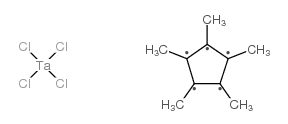71414-47-6
| 中文名 | 五甲基环戊二烯基四氯化钽 |
|---|---|
| 英文名 | Pentamethylcyclopentadienyltantalum tetrachloride |
| 中文别名 | 四氯化五甲基环戊二烯基钽(V) |
| 英文别名 |
MFCD00070463
carbanide,cyclopenta-1,3-diene,tantalum,tetrachloride |
| 熔点 | >300ºC |
|---|---|
| 分子式 | C10H15Cl4Ta |
| 分子量 | 457.98600 |
| 精确质量 | 455.94100 |
| LogP | 5.73000 |
| 储存条件 | 存放在充有干爽惰性气体的容器内,并放在阴凉,干爽处。储存的地方必须上锁,钥匙必须交给技术专家和他们的助手保管。避免湿气和水分。远离氧化剂。 |
| 稳定性 | 远离氧化物,水分。 |
| 计算化学 | 1.疏水参数计算参考值(XlogP):无 2.氢键供体数量:0 3.氢键受体数量:10 4.可旋转化学键数量:0 5.互变异构体数量:无 6.拓扑分子极性表面积0 7.重原子数量:15 8.表面电荷:-10 9.复杂度:72.9 10.同位素原子数量:0 11.确定原子立构中心数量:0 12.不确定原子立构中心数量:0 13.确定化学键立构中心数量:0 14.不确定化学键立构中心数量:0 15.共价键单元数量:11 |
| 更多 | 1. 性状:橙色粉末。 2. 密度(g/mL,25/4℃):未确定 3. 相对蒸汽密度(g/mL,空气=1):未确定 4. 熔点(ºC):200 5. 沸点(ºC,常压):未确定 6. 沸点(ºC,5.2kPa):未确定 7. 折射率:未确定 8. 闪点(ºC):未确定 9. 比旋光度(º):未确定 10. 自燃点或引燃温度(ºC):未确定 11. 蒸气压(kPa,25ºC):未确定 12. 饱和蒸气压(kPa,60ºC):未确定 13. 燃烧热(KJ/mol):未确定 14. 临界温度(ºC): 未确定 15. 临界压力(KPa): 未确定 16. 油水(辛醇/水)分配系数的对数值:未确定 17. 爆炸上限(%,V/V):未确定 18. 爆炸下限(%,V/V):未确定 19. 溶解性:与水反应强烈。 |
|
Section 1: Product Identification Chemical Name:Pentamethylcyclopentadienyltantalum tetrachloride, 98% CAS Registry Number:71414-47-6 Formula:[C5(CH3)5]TaCl4 EINECS Number:none Chemical Family:metallocene Synonym:Tantalum tetrachloride, pentamethylcyclopentadienyl complex
Section 2: Composition and Information on Ingredients IngredientCAS NumberPercentACGIH (TWA)OSHA (PEL) Title compound71414-47-6100%no datano data Section 3: Hazards Identification Corrosive to skin and eyes. Material hydrolyzes in contact with moisture releasing toxic and corrosive fumes Emergency Overview: of hydrogen chloride and aqueous hydrochloric acid. Primary Routes of Exposure:Contact with skin and eyes. Inhalation of dust. Eye Contact:Corrosive to the eyes. Skin Contact:Causes chemical burns to the skin. Inhalation:Forms hydrogen chloride in the presence of moisture. Inhalation will lead to burning of the respiratory tract. Ingestion:If large amounts ingested, severe burns to the gastrointestinal tract may occur. Corrosive to skin, eyes and respiratory tract. Causes eye and skin burns, dyspnea (difficulty breathing) and Acute Health Affects: pulmonary edema. Chronic Health Affects:No information available on long-term chronic effects. NTP:No IARC:No OSHA:No SECTION 4: First Aid Measures Immediately flush the eyes with copious amounts of water for at least 10-15 minutes. A victim may need Eye Exposure: assistance in keeping their eye lids open. Get immediate medical attention. Wash the affected area with water. Remove contaminated clothes if necessary. Seek medical assistance if Skin Exposure: irritation persists. Remove the victim to fresh air. Closely monitor the victim for signs of respiratory problems, such as difficulty in Inhalation: breathing, coughing, wheezing or pain. In such cases seek immediate medical assistance. Seek medical attention immediately. Keep the victim calm. Give the victim water (only if conscious). Induce Ingestion: vomiting only if directed by medical personnel. SECTION 5: Fire Fighting Measures Flash Point:no data Autoignition Temperature:no data Explosion Limits:no data Extinguishing Medium:carbon dioxide, dry powder or foam. If involved in a fire, fire fighters should be equipped with NIOSH approved positive pressure self-contained Special Fire Fighting Procedures: breathing apparatus and full protective clothing. Hazardous Combustion andIf involved in a fire this material may release corrosive hydrogen chloride fumes. Decomposion Products: Unusual Fire or Explosion Hazards: No unusual fire or explosion hazards. SECTION 6: Accidental Release Measures Spill and Leak Procedures:Small spills can be mixed with powdered sodium bicarbonate, lime, or calcium carbonate and swept up. SECTION 7: Handling and Storage Handling and Storage:Handle and store the material under an inert atmosphere of nitrogen or argon. SECTION 8: Exposure Controls and Personal Protection Eye Protection:Always wear approved safety glasses when handling a chemical substance in the laboratory. Skin Protection:Wear protective clothing and gloves. Consult with glove manufacturer to determine the proper type of glove. Ventilation:Material may emit corrosive fumes. Handle the material in an efficient fume hood. If ventilation is not available a respirator should be worn. The use of respirators requires a Respiratory Respirator: Protection Program to be in compliance with 29 CFR 1910.134. Ventilation:Material may emit corrosive fumes. Handle the material in an efficient fume hood. Additional Protection:No additional protection required. SECTION 9: Physical and Chemical Properties Color and Form:orange powder Molecular Weight:458 Melting Point:220° Boiling Point:no data Vapor Pressure:no data Specific Gravity:no data Odor:pungent odor Solubility in Water:reacts with water SECTION 10: Stability and Reactivity Stability:air and moisture sensitive Hazardous Polymerization:No hazardous polymerization. Conditions to Avoid:none Incompatibility:water and halogens Decomposition Products:carbon monoxide, carbon dioxide, tantalum oxide, chlorinated organics, organic fumes. SECTION 11: Toxicological Information RTECS Data:No information available in the RTECS files. Carcinogenic Effects:no data Mutagenic Effects:no data Tetratogenic Effects:no data SECTION 12: Ecological Information Ecological Information:No information available SECTION 13: Disposal Considerations Disposal:Dispose of according to local, state and federal regulations. SECTION 14: Transportation Shipping Name (CFR):Corrosive solids, N.O.S. Hazard Class (CFR):8 Additional Hazard Class (CFR):NA Packaging Group (CFR):II UN ID Number (CFR):UN# 1759 Shipping Name (IATA):Corrosive solid, N.O.S. Hazard Class (IATA):8 Additional Hazard Class (IATA):NA Packaging Group (IATA):II UN ID Number (IATA):UN# 1759 SECTION 15: Regulatory Information TSCA:Not listed in the TSCA inventory SARA (Title 313):Title compound not listed. Second Ingredient:none SECTION 16 - ADDITIONAL INFORMATION N/A |
|
生态学数据: 对水稍微有危害的,不要让未稀释或者大量产品接触地下水,水道或者污水系统。若无政府许可,勿将材料排入周围环境。
|
| 危害码 (欧洲) | C:Corrosive; |
|---|---|
| 风险声明 (欧洲) | R14;R34 |
| 安全声明 (欧洲) | S26-S36/37/39-S45 |
| 危险品运输编码 | UN 3261 |
| 包装等级 | II |


